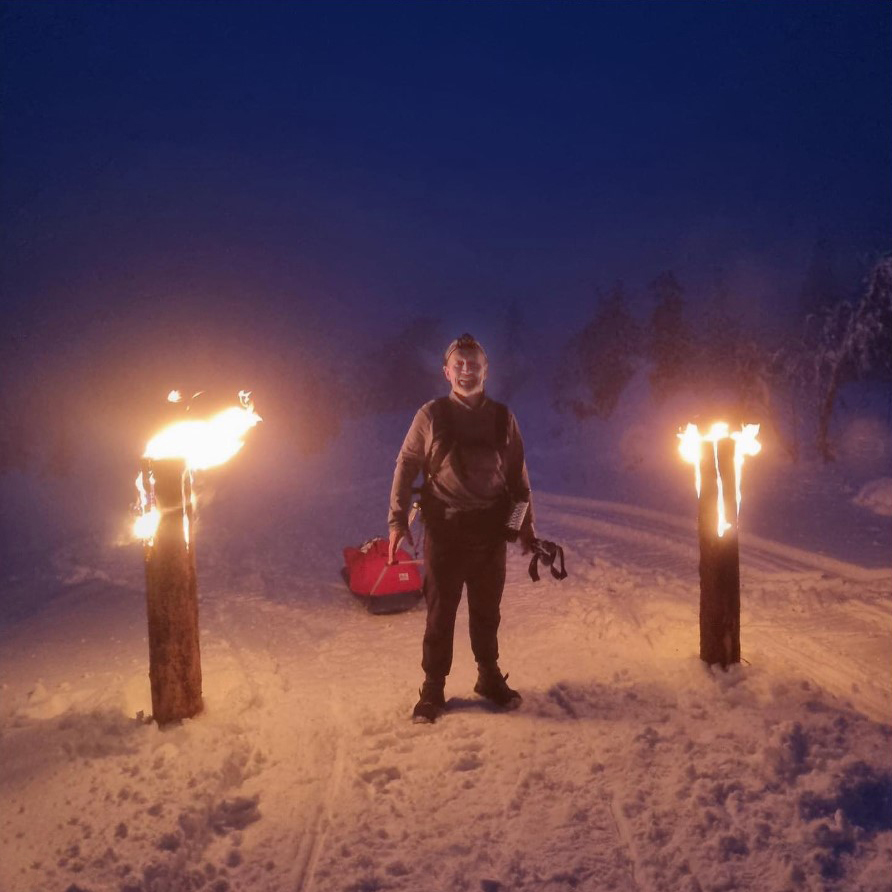
Forever fascinated and inspired by the Antarctic explorers, who undertook some incredible journeys and suffered the worst possible hardships, I figured it was time to head for somewhere cold so I could, albeit it in a small way, experience life on the snow and ice.
Cue the Lapland Arctic Ultra. 185 km of pulk (or sled) hauling in the Arctic Circle.
Swedish Lapland is an incredibly harsh and unforgiving environment, so participants must pass an interview to even reach the start line. Arctic neophytes like me also had to undertake a four-day winter survival course prior to the event.
I learned from the Arctic veterans that a successful event was dependent upon one-third preparation (the right kit, equipment and clothing), one-third physical fitness and one-third mental toughness. Observing competitors focus on the preparation element through the eyes of Emergenetics® was a fascinating experience.
Preferences in action
 Analytical
Analytical
It was an education to hear those with Analytical preferences sharing knowledge on all things kit, route, weather forecast and nutrition-related. One participant had created a spreadsheet of everyone’s checkpoint times over the previous two events so they could estimate how long it might take to reach each checkpoint and how long they would have to stay and rest.
From this data, flowed average speed calculations, alongside nutrition and hydration requirements. Electronic scales were used to weigh snacks and an evening was spent calorie counting sweets, nuts, chocolate and crushed Oreo biscuits so 1000-calorie bags could be packed, thus knowing the exact intake each day. Navigation included the use of ‘spliced gpx files’ to cover all elements of the route.
 Structural
Structural
Participants with Structural preferences had pulk packing and sleeping systems down to an art form. Watching a cyclist pack his ‘fat bike’ (a mountain bike with very wide tyres) for an unsupported journey that could last around 8 days, was enlightening. Every inch of space utilised, every bag labelled with a white pen on black masking tape so items could be located quickly at temperatures capable of reaching minus 30 degrees. Nutrition and hydration were placed within easy reach of the handlebars.
The organisation of bivouac (bivvy) and tent camps was second to none. Pulks adjacent to bivvy’s for easy access. Cooking space right next door on the other side, and even a snowshoe-tramped walkway off to the ‘bathroom’ in the woods.
 Social
Social
Everybody had a different way of undertaking the preparation required for an Arctic ultra and those with Social preferences seem to discover most of them by building relationships, quickly. Swift to praise or compliment, they ended up in knowledge-sharing conversations with the whole cohort. The lady from Great Britain who had the nightmare of her suitcase ending up in the US had several people empathising and sacrificing their own kit so she could still take part. The German guy who needed to swap cabins midway through the training arrived with cans of beer as a ‘hello’ to his new Great Britain cabin buddies who, also having a Social preference, had a cup of tea waiting for him.
Conversing with the Socially minded participants, it transpired that they came as much for the Arctic ultra community as they did to race. It was a real surprise (and pleasure) to be part of an ego-free group who were literally doing whatever they could to help their competitors.
 Conceptual
Conceptual
The survival training facilitators had a mantra of learn, repeat and adapt. Mindsets needed to be in ‘growth’ mode to be completely open to the fact that there might well be a better way of doing something. The trainees with Conceptual preferences loved going out every day experimenting. Changing layering and footwear, trying different clothing combinations, amending pulk layouts and tasting different expedition foods. The question they constantly asked fellow participants after trail practice sessions was, “What will you experiment with tomorrow as a result of today?”
Their bivvy set ups had the essential elements required, and it was intriguing to see the Conceptual preference go ‘off piste’ to create something a bit different. It was clear they saw the instructor’s demonstration camp purely as a guide. They then appreciated the freedom and opportunity to create their own version.
 Expressiveness
Expressiveness
It was fascinating to watch how each person processed their thoughts. The first-third Expressive competitors were thoughtfully assessing their strategies, offering brilliant insights when asked.
I found it incredibly useful to cabin share with someone with a third-third Expressive preference. He was constantly thinking out loud on both strategy and tactics and, with previous Arctic experience, the information he shared in the process was often gold dust to me. His need to express often involved him asking questions of me such as, “I’m not sure whether to do x or y, what are you planning to do?” This enquiry automatically led to me sharing my thoughts with him and a subsequent discussion on pros and cons. With hindsight, it was invaluable interaction time that very much shaped my race plan.
 Assertiveness
Assertiveness
It was relatively easy to spot where people placed on the Assertiveness spectrum through observation and language. One guy had a clear need to be at the front even on the practice training days. His self-awareness helped him realize he needed to manage his pace to avoid ‘blowing up’ mid-way into the race.
It was also interesting to hear different competitors challenge the decision of another who had opted to carry water in a bladder worn on their back. Third-third Assertive language was very direct, pointing out the danger of the risk of freezing and/or leaking, not to mention the excessive sweat it would cause. First-third Assertive language was more questioning, “Is there a reason…What I found was… It might be an idea to…” Similar advice communicated in two very different styles.
 Flexibility
Flexibility
My second-third Flexibility reasoned that it was best to hold off any decision making on the race plan until such time as I had completed the training and spoken to as many people as possible, particularly the veterans.
One guy, an Arctic first timer, communicating with first-third Flexible language, arrived with his plan and never deviated from it throughout the race. His clearly articulated goal was to complete the race, which he did, looking as fresh as a daisy after 185km. His face couldn’t hide his delight as he crossed the line exactly when he planned to. It was a very different story from some other competitors who talked of “going with the flow” depending on conditions, temperatures and how they were feeling.
Key learning
I benefited enormously from an awareness of my own preferences and, as importantly, non-preferences. With hindsight, the biggest leap was stepping away from my Structural mindset of “It ain’t broke, so why fix it” and leaning into the “test and learn” methodology of the Conceptual preference – some distance for me to travel.
Even after returning from a practice run where I was relatively happy with kit, layers or pulk set up, I would commit myself to venture out the following day trying something new that might just squeeze out another ounce of performance during the race. An eventual second-place finish suggested time spent flexing out of preference was time well spent.

What could greater self-awareness do for your performance? Explore our solutions to learn more or fill out the form below to speak with one of our team members today.
 Print This Post
Print This Post
